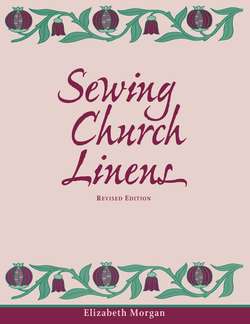Читать книгу Sewing Church Linens, Revised Edition - Elizabeth Morgan - Страница 12
На сайте Литреса книга снята с продажи.
The Holy Linens
ОглавлениеI am a Christian of the Episcopal denomination, which means, in the context of this book, that I will be writing about the linens used in the Episcopal churches. Other denominations have different linens and give them different names: Methodists call our fair linen a communion cloth, Roman Catholics shape their purificators differently and call the equivalent of our altar guilds, rosary societies. Whatever the size, shape, or name, the techniques used in constructing these linens remain the same.
The church linens are not in themselves holy. They are holy by virtue of the purpose they serve. The holy linens are those that come in contact with the consecrated elements—the Body and Blood of our Savior, Jesus, who is the Christ.
Many books and pamphlets give standard sizes for the linens. I don't think we can establish standard sizes. Corporals, purifications, and chalice veils should be sized according to the size of the altar and chalice. Some priests prefer larger lavabo towels than others. These decisions can be based upon the needs and tastes of your own church. I would suggest, however, that you make a decision and stick with it. Many sacristies are plagued by “mystery linens.” Mystery linens are the ones that appear this week as purificators and next week as corporals because their size and/or embroidery is ambiguous.
The purificator is used to wipe the edge of the chalice as the consecrated wine is being administered. Roman Catholic purificators are rectangular. In Episcopal churches the purificator is square and is folded in thirds twice.
The lavabo towel is used to dry the hands of the priest prior to the consecration of the elements. The lavabo towel is rectangular and sometimes serves double duty as a baptismal towel. It is folded in thirds and then in half.
The corporal is placed underneath the vessels containing the host and wine during consecration. Its purpose is to catch and contain any bits of the host so that they may be disposed of properly. (This is done by emptying them into the piscina or by taking the corporal out of doors and shaking the crumbs on the ground.)
The folding of corporals is an issue. I cannot tell you how often I have been asked by clergy to teach the altar guild how to fold corporals properly. It may appear fussy, but folding the corporal properly is important.
When our clergy celebrate communion, they not only prepare for us the holy feast, they are also in prayer. We must do all we can to support them during this time. A corporal that must be adjusted because it is upside down or wrong side up is not merely ungraceful and an inconvenience, it is disruptive to the worship of the priest. I have given a simple method for folding corporals in the chapter on Washing, Ironing, and Folding. It will be appreciated by every deacon and priest.
The chalice veil is a post-communion cover for the chalice used in place of burse and veil. Following the ablutions, the purificator is placed in (or on) the chalice, the paten (if used) is placed on top, and the pall is laid on top of the paten. The chalice veil then is laid over the top.
Although the use of a post-communion chalice veil is a time-honored tradition, we haven't seen much of it in recent years because it was supplanted by the use of burse and veil.
The burse and veil are processional vestments. They form a portable package in which the eucharistic vessels and elements can be brought to the altar in procession. As it becomes less common to process the vessels and elements, parishes are returning to the use of chalice veils.
I am not aware of any formal traditions attached to the use of the chalice veil. For instance: is it used only to cover vessels left on the altar, or may it be used to cover vessels placed on the credence table? As neither Leviticus nor Deuteronomy speaks to this question, the answer must be “whatever is reasonable and proper.” My own sense would be that a chalice veil may be used to cover vessels when they are left on the altar but not when they are removed from the altar to the credence table.
As with corporals, the folding process should result in decorum rather than chaos. Lay the ironed chalice veil right side up, the cross away from you. Fold down the top third. Fold up the bottom third. Fold in the right-hand third. Fold in the left-hand third. This creates the appearance of a book.
When the first two folds are opened, the priest/deacon needs only to lift up the hem. The veil will open correctly to be laid neatly over the chalice with a minimum of fuss.
The pall is a square cover for the chalice made of lightweight Plexiglas covered with linen. Its original purpose was to keep unwanted litter out of the chalice. It also serves as a surface to support the burse (if one is used) or the corporal (if it isn't).
The credence cloth is the cloth that is placed on the credence table on which the vessels are kept before they are put on the altar for the Eucharist service.
The fair linen is the covering for the altar and is symbolic of the linen cloth in which the body of our Lord was wrapped when he was taken from his cross and placed in the tomb. From this comes the stress upon the use of linen for the holy linens. The word “fair” in this context means “lovely.”
